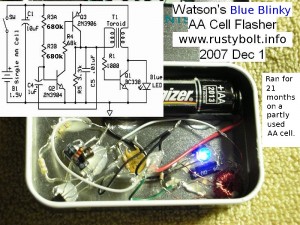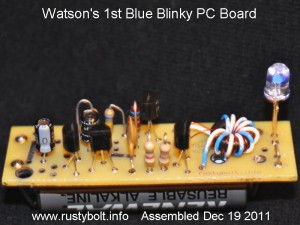I built this Blue Blinky and installed the partly used AA cell on Dec 1, 2007. For most of the next 21 months, on or about the first of the month I published a short blog on how it was doing. As the cell ran down it got dimmer and dimmer, but continued to flash, with the speed increasing toward the end. If I remember correctly, the cell’s voltage dropped down to under 0.8 volts, and it still kept on blinking. I think it deserves a prominent place because of the apparent low current draw and longevity of the battery. I uploaded a 20 sec video of them flashing to Youtube, so check it out. The middle two turn off when I shine the light on them, the top and bottom don’t turn off because they don’t have the LED sensor. And it’s cheaper and easier to get a red LED than a CdS photocell.
I have come across several of the circuits on David Johnson’s website that have very long battery life, but those usually have a CMOS chip, which inherently is very low current. My Blue Blinky uses three regular transistors and doesn’t require any chips, and does a good job of being a current miser with a long battery life.
Daylight shutoff I updated the schematic (not shown on this one ) to include a CdS photocell across the emitter to base of Q3. When the Blue Blinky is in the dark, it will run, and when the ambient light is like that in a normally lit room it will shut off. This should double the lifetime of the battery depending on the light/dark ratio. Having the room lights on after dark may keep it off, so the battery life may be further extended. But I really don’t have another 2 to 4 years to test it and find out. 😛
) to include a CdS photocell across the emitter to base of Q3. When the Blue Blinky is in the dark, it will run, and when the ambient light is like that in a normally lit room it will shut off. This should double the lifetime of the battery depending on the light/dark ratio. Having the room lights on after dark may keep it off, so the battery life may be further extended. But I really don’t have another 2 to 4 years to test it and find out. 😛
One reason I say “test it” is because the photocell will shut off the flasher part. A JT, for instance, may run, if left undisturbed, until the cell voltage drops below 0.5 volts (some have claimed lower than 0.4V). As long as the JT is running, there is enough voltage to keep it running. But if you disconnect the cell, when it is reconnected the JT may not start until the cell voltage rises to around 0.6V.
Because the Blue Blinky will flash down to a battery voltage of below 0.8 volts if left undisturbed (without a photocell that turns it off every day), I could not say for certain if it would work down to that low battery voltage with the photocell turning it on and off. I guess one could check its performance by using a ‘dead’ AA cell that has a voltage of less than 1 volt, and running it for a few months on what little ‘juice’ is left in that cell. At least one would not have to wait for years.
Operation I used a standard two transistor flasher circuit found at a number of places on the net, including Bill Bowden’s website. However it does not have to supply the 70 or more mA current the Joule Thief requires, it only has to supply the base bias current to the base of the JT transistor, which is only a milliamp or less. The flash rate is determined by the C4 1uF capacitor and the two resistors R3A and B. I found that if R3 is too low, the flasher can become unstable and refuse to flash or turn fully on. I think it is better to keep R3 at more than 1 megohm, and change C4 if you want to adjust the flash rate.
The Joule Thief part of the circuit is pretty much just a standard JT. It uses a coil made from a ICH-YJ41003TC core, with ten turns of 24 AWG solid telephone wire, and 10 turns of 30 AWG enameled magnet wire. The coil inductance is in the mid to high 200s of microhenrys. The feedback winding is not connected to the battery, instead it is connected to the flasher’s output. The flasher’s short pulse turns on the JT for a short period of time and the blue LED lights up brightly. The relatively long stretch of dark time between blinks is what extends the battery life. The flasher, as I said, turns the base bias to the JT on for a very short period of time; it is off most of the time. This is how the Blue Blinky makes the battery last so long.
The C5 bypasses the pulses of the feedback winding to minus, so that the base of Q1 gets its full voltage as if the winding was directly connected to positive. (Now that I reread the preceding sentence, it sounds too abstruse [difficult to comprehend]) The R5 resistor is to discharge C5 so the JT stops abruptly. I have not tried changing it or removing it, but the JT may work as well with a higher value or with it removed. But then see the June 25, 2012 update below.
Update Dec 9, 2011 – I have spent a lot of time the last few evenings designing the ‘Blue Blinky’ PC board with ExpressPCB. I started out with a rectangular board not far from being square. I could get 6 of them on a “miniboard” (size 2.5″ by 3.8″). But then I realized I could save a battery holder by making the PC board longer and about as wide as a AA cell. The contacts on the ends of the board will be made out of a loop of steel wire cut from the end of a heavy paper clip. I got this idea here. I bought some of his Night Joule Thief boards and built a few so I know they work okay (BTW this guy has some fantastic LED art – check out his website). I decided to change from the nearly square rectangular board to a much longer and thinner board to allow it to become the battery holder. It’s tedious work but I pretty much have it down to where I want it, and I can get five of them on a miniboard, so a standard order of three miniboards or fifteen of the PCBs will come to something around 65 dollars US. That’s about $4.33 a PC board, but I’ll have to cut them up when they arrive. The glass epoxy board is hard on the mini hacksaw blades I use so I’ll wear out a few of those and it will cost somewhat more as a consequence, not to mention a little sweat equity. But hey, that’s what it’s all about — it’s a hobby(?)…
Update Dec 10 – In my Blinky I first used the CdS photocells just like I discussed above. But CdS photocells are uncommon, whereas red LEDs are as common as dog doo-doo. So I changed over to a red LED used as a light sensor (maybe I should call it a LSD or light sensing diode). The LED is just like a photovoltaic solar cell but the surface area is very tiny, so it can only generate microamps. But that’s good enough to drive the base of a transistor which then amplifies the current up to whatever is needed. I just put the red LED between the base and emitter of a 2N3904 and it will turn the transistor on when it’s lit. I connected the 2N3904 transistor’s emitter to negative and collector to the base of Q2. The LED turns on the 2N3904 so it shorts out the current coming through the two 680k resistors and the flasher circuit cannot flash any more. The two 680k (or one 1.3M) resistors will conduct a microamp or so during shutoff, which is so low that it would take many, many years to drain the battery.
LSD Sensitivity The LSD (light sensing diode) shuts off the Blue Blinky when it’s daytime outside, even in the shade. But inside the ambient light is lower, and my only problem is that the clear lens red LEDs I used are very directional, and only turn it off when the LSD is pointed directly at the ceiling light. So I have to figure out how to get the LED to turn on when light is shining from the sides. Maybe I can diffuse the light by making the LED rough on the top with some sandpaper. Well, I tried dulling the top of the light sensing LED with some sandpaper. It still is directional. The dullness reduces the light a bit so it’s probably less sensitive. But it still turns off when I point the top of the LED towards the ceiling light. I changed to an orange LED, hoping it would be a bit more sensitive, but it is still directional. I sawed off the round top of the led so the lens was flat, then polished it with some very fine sandpaper to smooth the roughness out. It lost too much sensitivity, and wouldn’t turn off when I pointed it at the ceiling light. I changed it back to a regular red LED.
I had been using the PN2222A for the LSD current amplifier. This transistor has a medium to high gain of 100 to 300 at 10 ma current. But the LSD puts out a few microamps, and the PN2222A amplifies that to a small fraction of a milliamp at a fraction of a volt. The datasheet for the PN2222A says that the gain could be as low as 35 at 1/10 milliamp. In other words, the PN2222A’s current gain gets much lower at low currents. What I need is a transistor that has high gain at low currents. I chose the BC550C, which is made for low current, low noise amplifiers (it is the same as the BC547C). It has a current gain of 420 to 800 at 2 mA, which is a lot more than the PN2222A. I removed the PN2222A and put in the BC550C, and the difference is like night and day, no pun intended. The LSD now turns off the Blue Blinky with just the ambient room light; it does not have to be pointed at the ceiling light.
 Update Dec 19 – I received the Blue Blinky PC boards yesterday morning and sawed one off, and assembled it (see the picture nearby). It worked like a champion as soon as I connected the AA cell, but I had to bend the heavy paper clip battery contacts a bit to get the battery to stay in its place. The flash rate is a bit faster than 1 per second, actually about 1.1 per second. I’ve since assembled three more, and all work just fine. One had two red LEDs in series in place of the blue LED, but a Red Blinky just doesn’t have that poetic sound to it. By the way, the picture to the right does not show the red “LSD” directly behind the leftmost transistor – it works great without it.
Update Dec 19 – I received the Blue Blinky PC boards yesterday morning and sawed one off, and assembled it (see the picture nearby). It worked like a champion as soon as I connected the AA cell, but I had to bend the heavy paper clip battery contacts a bit to get the battery to stay in its place. The flash rate is a bit faster than 1 per second, actually about 1.1 per second. I’ve since assembled three more, and all work just fine. One had two red LEDs in series in place of the blue LED, but a Red Blinky just doesn’t have that poetic sound to it. By the way, the picture to the right does not show the red “LSD” directly behind the leftmost transistor – it works great without it.
Update Jan 15 2012 Another pic of a slightly modified PC board, which I received in another order. I positioned the battery clips so they were closer to the ends of the AA cell. A few other mods, but it looks a lot like the original boards. I’m happy with the battery holders, I have used paper clips and heavy bare copper wire, I think it’s 20 AWG or 18 AWG.  I changed the .01 uF capacitor to .001 or 1 nF, which seems to work just as well. I used two yellow LEDs on this board. I haven’t installed the red LED used for sensing the light. I changed the transistor farthest to the left from PN2222 to BC550C, which is more sensitive to light. The resistor laying on the board behind the electrolytic cap is a 1.5 megohm which replaces the two 680k resistors; it determines the flash rate. The reason I originally used two 680k resistors in series was that the total added up to 1360k, which was closer to the 1 second flash rate I wanted. But the 1 μF is an electrolytic, which has a typical tolerance of + or – 20%. That’s quite wide, so I figured that I could put a 1 Meg resistor in one of the two positions, and then use a pot to adjust the flash rate to about 1 second. When I’ve found the optimum point, I remove and measure the pot, and then put in a resistor close to that value, such as 390k. But I’ve been putting in two 680k or a 1.3 Meg, and that’s close enough. Changes in the temperature will cause variations in the flash rate, so it’s not really possible to get it exactly 1 second.
I changed the .01 uF capacitor to .001 or 1 nF, which seems to work just as well. I used two yellow LEDs on this board. I haven’t installed the red LED used for sensing the light. I changed the transistor farthest to the left from PN2222 to BC550C, which is more sensitive to light. The resistor laying on the board behind the electrolytic cap is a 1.5 megohm which replaces the two 680k resistors; it determines the flash rate. The reason I originally used two 680k resistors in series was that the total added up to 1360k, which was closer to the 1 second flash rate I wanted. But the 1 μF is an electrolytic, which has a typical tolerance of + or – 20%. That’s quite wide, so I figured that I could put a 1 Meg resistor in one of the two positions, and then use a pot to adjust the flash rate to about 1 second. When I’ve found the optimum point, I remove and measure the pot, and then put in a resistor close to that value, such as 390k. But I’ve been putting in two 680k or a 1.3 Meg, and that’s close enough. Changes in the temperature will cause variations in the flash rate, so it’s not really possible to get it exactly 1 second.
Back to experimenting…











